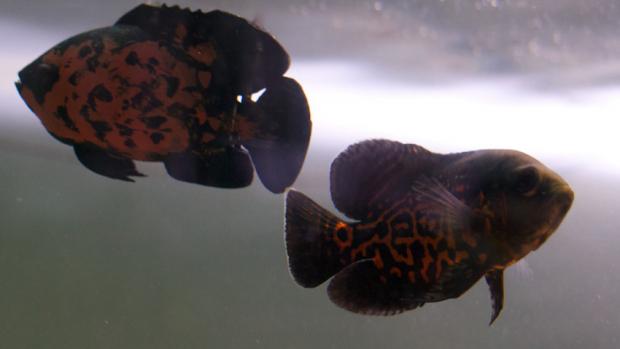Gotcha! Ultra-Realistic Robot Proves There's More Than One Way to Scare A Fish

In the world of the tiny zebrafish, the predatory red tiger oscar is the stuff of nightmares. And while the species has no natural reason to fear robots, researchers at the NYU Polytechnic School of Engineering have published the first study showing that, in a side-by-side comparison, a robotic predator can spook zebrafish just as well as the real thing. Their results may help advance understanding of fear and anxiety in animal populations, including humans.
The study, along with an image of the strikingly lifelike robotic model, is the cover story of the forthcoming June issue of the journal Zebrafish.
Zebrafish are a highly versatile species that are increasingly taking the place of more complex animals in behavioral studies. They have been used to explore social behavior, as well as aspects of cognition, anxiety, and fear.
However, all experiments using live animals have limitations. Their behavior can be unpredictable, and factors such as environment and fatigue can impact results. Maurizio Porfiri, professor of mechanical and aerospace engineering at the NYU School of Engineering, creates bio-inspired robotic models that serve as fully predictable, controllable stimuli alongside live animals. His experiments have shown the advantages of using robots in studies of fish behavior, including repeatability and consistency.
For this first-ever comparative test of fear, Porfiri and his team devised an experimental tank divided into three compartments. The first was left empty, the second was occupied by a live zebrafish, and the third compartment was for one of three different experimental stimuli: a live red tiger oscar, a computer animation of a swimming oscar, or the robotic fish replica. They also performed a control trial in which the zebrafish simply swam in the tank with no stimulus.
The zebrafish exposed to the live red tiger oscar and those exposed to the robotic replica showed unequivocal fear responses. They spent far less time in the area of the tank where the real oscar fish or the robot was placed. Importantly, the researchers also noted that the avoidance response of zebrafish toward the robot was more consistent than toward the live red tiger oscar.
“Avoidance isn’t the only way we can tell a zebrafish is scared,” said Porfiri. “When these fish are afraid, they also swim differently, and we were surprised to find that the robotic fish could produce an even stronger fear-related response than the actual live predator.”
The zebrafish showed little or no response to the animated images of a red tiger oscar. Because previous studies have shown the effectiveness of such animations in impacting zebrafish behavior, Porfiri suspects that this particular animation was not perceived as especially threatening.
The researchers believe that this is the first study to directly compare the response of zebrafish to both live and robotic predators. Porfiri commented that the choice of predator, the red tiger oscar, played a significant role in the outcome of these experiments.
“The oscar fish is a known zebrafish predator, but it’s not the most threatening one out there,” Porfiri said. “We chose a predator that could be relied upon to scare the zebrafish, but not to the point of complete avoidance that would mask what we were trying to uncover.” This slightly moderated fear response allowed the team to examine the full scope of fear-related behaviors in these fish, as well as prove that they could induce them with both a robot and a live animal counterpart.
The research team includes NYU School of Engineering research scholars Fabrizio Ladu and Tiziana Bartolini; Flavia Chiarotti and Simone Macrì, collaborators from the Istituto Superiore di Sanita` in Rome, Italy; and Sachit Butail, an assistant professor at Indraprastha Institute of Information Technology Delhi, in India. Sarah Panitz, a 17-year-old senior at Brooklyn Technical High School, played a seminal role in the design and execution of these trials. This is Panitz’s first scientific publication, following two years as an intern in Porfiri’s lab.
Porfiri and his team have a long history of exploring the benefits of using robotic replicas in animal experiments. Their findings have shown that robots are powerful experimental tools that may help reduce the number of animals used in behavioral science studies.
This research was supported by grants from the National Science Foundation. The full paper, Live Predators, Robots, and Computer-Animated Images Elicit Differential Avoidance Responses in Zebrafish is available here.




